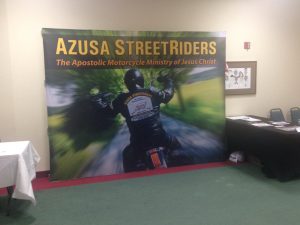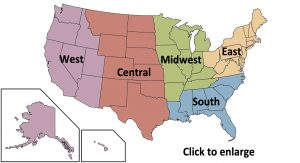First off all of us should take a moment and thank the Lord for Brother & Sister Mcleod, Brother & Sister Perry and all of the members of the New Haven, CT Chapter for a Job well done presenting the Azusa StreetRiders Ministry at the WinterFire conference. Job Well Done!
Bro Thompson, ASR National President
“THAT WORKED” by Brother David Mcleod

Bro Jeff Banores and Bro Dave McLeod
standing in front of our new
Azusa StreetRiders display booth
backdrop
We, as Azusa StreetRiders, were privileged to have an opportunity to explain our Motorcycles for Missions Ministry to numerous Oneness people during the 3rd week of February.
The venue was the major WinterFire Conference that occurs annually in the Hartford, CT area. It’s the premiere gathering of Apostolics for the Northeast Quadrant of North America.
It was also the first time to utilize our new ASR display backdrop.
Have a look at the attached photos. It’s 10 ft wide and 7ft high. The “face” of the unit is fabric and our favourite “Azusa Biker” is the visual centre point. The fabric is attached to the frame using Velcro. It takes about one minute to either set it up or take it down. Simply remove the display from its wheeled container and pull it apart. It unfolds and raises as it opens
People walking past us would literally stop and stare. It’s that effective!
This would give us an opening to say something like “Do you ride?” And the conversation was off and running.
I got to meet many of the New Haven, CT chapter members as we were on their home turf, so to speak. They’re to be commended for the ease with which they were able slide into biker related conversations. I’m convinced that these guys are on a 1st name basis with about half the population of New England! Hugs and “Biker Handshakes” were the order of the event.
Chapter President, Jeff Banores, has some really good plans to promote the ASR message in his area. President Jeff now has the contact information for five prospective members. We probably wouldn’t have found these folks had it not been for our WinterFire participation.
We’re looking forward to riding with any of the New Haven members who are planning to attend the National gathering this summer.
Please allow me to share some insights gathered in Hartford.
There are numerous District Conferences, Men’s Conferences, Youth Conferences, etc that fall under the umbrella of our various Oneness organizations. These events are where we will have an opportunity to meet prospective members and raise our profile.
The display is guaranteed to attract attention. We have the “common denominator” of our shared interest in all things “motorcycle.” In Hartford, we heard things like:
- “My husband rides a motorcycle. He’s not as regular with his church attendance as he should be. I wish that he could meet you people.”
- My sister-in-law lives in Texas? Do you know if you have anyone in Lubeck (sp) that could contact her? She sure loves her Harley.”
- “We have two guys in our home church in New Jersey that belong to the CMA.”
- Our new “May I Pray for You” patch drew a lot of attention. People were asking us if we had any for sale. I was also asked if we had “bumper stickers” of the patch. – Good idea.
- The personal connection of the New Haven chapter members made a big difference at this conference. Chapter Presidents,,,, no one knows your area better than you……. Get out to your District events and see what will happen. We’re the largest “Oneness Apostolic Motorcycle Ministry” in the world. Let’s be scriptural. “Everyone Win One” would double our membership. It was an honour to represent our Ministry at this event. Both Brenda & I were ministered to by the anointed preaching The conference organizers did a great job on tis years ministers.
Dave McLeod / ASR Director for Canada & Atlantic Canada Chapter President











